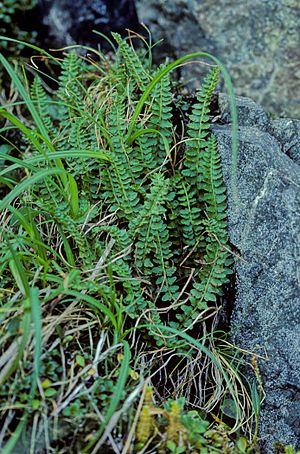Aleutian holly fern facts for kids
Quick facts for kids Aleutian holly fern |
|
|---|---|
 |
|
| Conservation status | |
| Scientific classification | |
| Genus: |
Polystichum
|
| Species: |
aleuticum
|
The Aleutian shield fern (scientific name: Polystichum aleuticum) is a very rare plant. It is also known as the Aleutian holly fern. This special fern is an endangered species, meaning it is at high risk of disappearing forever.
You can only find this fern in one place: Adak Island in Alaska. Adak Island is a remote part of the Aleutian Islands, which stretch out into the northern Pacific Ocean. Because it lives only in one specific area, it is called an endemic species.
In 1992, only 112 of these ferns were known to exist in the wild. Because it was so rare, a special plan was started to help it survive. The Aleutian shield fern is the only native plant from Alaska that is on the federal endangered species list. Today, fewer than 150 of these plants are known to exist, making it one of the rarest plants in North America.
Scientists first described the Aleutian shield fern in 1938. However, they couldn't find it again until 1975. That's when a group of these ferns was discovered on Mount Reed, also on Adak Island. More groups were found on Mount Reed in 1988, 1993, and 1999. Even after many searches on other nearby islands since 1988, no other groups of this fern have been found.
Where Does the Aleutian Shield Fern Live?
The Aleutian shield fern is quite unique. It doesn't look like any other shield fern found in North America. Because of this, scientists first wondered if it even belonged to the Polystichum group of ferns.
However, they later found that it is similar to a small Polystichum species. This similar fern grows in the mountains of southwestern China and the Himalayas. This connection shows how plants can sometimes have relatives very far away!
What Does the Aleutian Shield Fern Look Like?
The Aleutian shield fern usually stands about six inches (15 centimeters) tall. It grows upright and often appears by itself, not in large groups.
- Roots: It has a strong, fibrous root system. You can often see old, dead leaf parts still attached to its roots.
- Leaves: Its leaves are called fronds. They are visible during the growing season and can be light or dark olive green. The fronds get narrower towards the top.
- Leaflets: Each frond has 15 to 25 pairs of smaller leaflets. These leaflets are called pinnae. They are usually 4 to 8 millimeters long and either attach directly to the main stem or have very short stalks.
- Spores: On the underside of the upper leaflets, you'll find small, round structures called sori. These sori produce spores, which are like tiny seeds that help the fern reproduce. Each leaflet usually has one sorus, sometimes two. A small flap of tissue, called an indusium, protects these sori. The fern produces its spores in July and August.


